Paper in Valeur, H. (2014) India: the Urban Transition – a Case Study of Development Urbanism. Copenhagen, The Architectural Publisher, pp. 196-221.
Table of Contents
1. Urbanization and poverty alleviation
2. The numbers game
3. What is “slum”?
4. The Rajiv Awas Yojana
5. Bangalore – the never-ending promises
6. Chandigarh – the game of corrupt politics
7. Conclusion
Abstract
This paper examines the uncertainty of the numbers related to slums in India, the promises that are being made and the programs that are being initiated to eradicate slums. And it examines the failure of these promises and programs: a failure that is not only depriving poor rural migrants of the chance to improve their lives by moving to cities but is also depriving society of these people’s productivity.
1. Urbanization and poverty alleviation
Compared to China, where rapid urbanization seems to have been instrumental in lifting several hundred million people out of extreme poverty during the past three decades, urbanization in India has been slow and, as a possible consequence, poverty alleviation has been almost stagnant.
Of the more than 1.2 billion people living in extreme poverty throughout the world,1 one-third now live in India.2

Most of these people live in rural areas and each year many migrate to cities in search of livelihood opportunities. Here, they end up in slum areas or in areas that are not officially categorized as slum but where living conditions are still cramped and squalid or they end up living on the street.
Considering that these are the prospects, it may be no wonder that urban growth has been relatively moderate in India.3
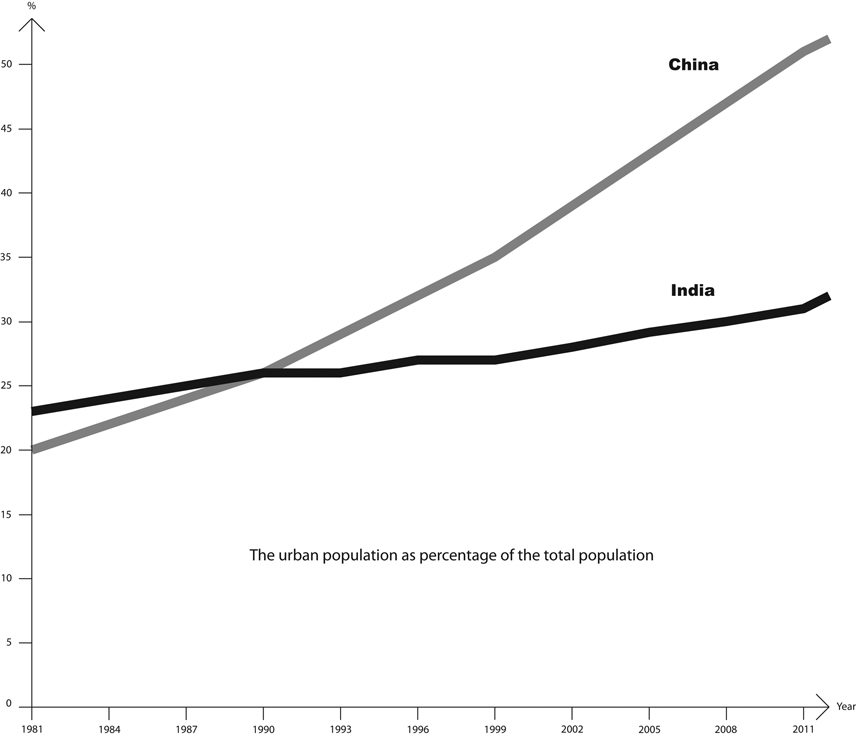
2. The numbers game
Despite rural-to-urban migration,4 however, the relative number of slum dwellers seems to have dropped significantly during the past decade. Thus, while the 2001 Census found 22.6 percent of the urban population in India living in slums,5 the 2011 Census found “only” 17.4 percent.6
But one has to be extremely cautious about these numbers.
In 2010, the Ministry of Housing and Urban Poverty Alleviation estimated that there would be 93 million slum dwellers in Indian cities in 2011,7 corresponding to 25 percent of the total urban population, but a year later, the 2011 Census found “only” about 66 million slum dwellers in the Indian cities.8
Such a dramatic change in numbers – a reduction (or miscalculation) of roughly 27 million in one year – calls to mind the reporting of massive food production in China during “The Great Leap Forward” at a moment in time when, in fact, millions of people were starving to death.
The number of slum dwellers is obviously a matter of definition and that definition is obviously subject to individual interpretation.
For the 2011 Census, slum was defined as “areas where dwellings are unfit for human habitation by reasons of dilapidation, overcrowding, faulty arrangements and design of such buildings, narrowness or faulty arrangement of street, lack of ventilation, light, or sanitation facilities or any combination of these factors which are detrimental to the safety and health.”9
The 2011 Census included slums that had been notified or recognized by local governments as well as slums that were identified but not officially notified or recognized, which accounted for more than 1/3 of the total number.
It was found was that out of all the slum households, 71.9 percent had at least four family members but 49.2 percent had only one room or no rooms at all. Given the fact that rooms in slums are usually small, these numbers indicate that the living conditions for many slum dwellers are thus extremely cramped. And, as given by the definition that was used for the 2011 Census, they are also unhygienic, unhealthy and unsafe.
However, on many indicators, there doesn’t seem to be all that much difference between slum and non-slum in cities. For instance, the percentage of urban households who own their house is the same for slum dwellers as it is for non-slum dwellers (70 percent), according to the 2011 Census. How can this be explained?
Slum dwellers rarely own the land they live on but they may own the scrap that constitutes their dwelling. Owning some scrap material on “illegally” occupied land is obviously not the same as owning a well-constructed dwelling on “legally” occupied land.10 But when we look only at the statistics, the two situations may appear to be the same.
The reason why more households in slums (65 percent) get tap water from a treated source than urban households in general (62 percent), unbelievable as this may sound, as well as the reason why nearly the same portion of the residents – 91 percent of households in slums and 93 percent of urban households in general – have access to electricity, may be explained, at least in part, by the unlawful tapping of these resources.
Nevertheless, it is positively surprising that the vast majority of households in slums apparently have bathing and latrine facilities on the premises – respectively, 81 and 66 percent, as compared to 87 and 81 percent for urban households in general – even if the quality of these facilities might vary considerably and certainly, 22-32 million slum dwellers without latrine facilities still constitutes a huge problem, both for the individuals and for society at large.
Perhaps even more positively surprising is the fact that 53 percent of households in slums apparently avail themselves of banking services, as compared to 68 percent of urban households in general. Again, making use of banking services may signify different things but inasmuch as it includes obtaining loans, this may be very good news, given that the inability to obtain legitimate credit, as a consequence of the lack of property rights, is often seen as a major obstacle standing in the way of slum-dwellers’ chances to expand their economic activities and thus improve their economic situations.11
It should also be noted that 70 percent of households in slums have television sets, 64 percent have cell phones and 10 percent have computers, as compared to, respectively, 77 percent, 64 percent (the same!) and 19 percent for urban households in general.
Even the distribution of private vehicles is, apparently, relatively even – with 40 percent of households in slums having a bicycle and 4 percent having a car, while the corresponding numbers for urban households in general are, respectively, 42 and 10 percent.12
But, as has been mentioned before, one has to remain extremely cautious about these numbers.
Thus, while it is hard to think of any town in India without some kind of slum, the 2011 Census was reporting the presence of slums in “only” 63 percent of the surveyed towns.13
And while 41 percent of the urban population in a relatively well-off state like Andhra Pradesh lives in slums (11,573,661 out of 28,353,745), in Bihar, the poorest state of India,14 only 8 percent of the urban population lives in slums (927,631 out of 11,730,000), according to the 2011 Census.15
The reason could be that the rural population of Bihar migrates to cities in other states, such as Andhra Pradesh, rather than to cities in Bihar. However, migration only accounts for a smaller part of urban growth and the urban population has actually grown, marginally, more rapidly in Bihar than it has in Andhra Pradesh between 2001 and 2011.16
Thus, the numbers of the 2011 Census are widely disputed,17 as expressed in the following two comments on a news story about the census:18
“This report seems to be grossly inaccurate and it appears that there is Government hand in these figures. The figure has got to be much higher. Also, a SLUM needs to be redefined. The major reason for this is — SIPHONING OFF OF PUBLIC MONEY BY POLITICIANS AND BUREAUCRATS.”
Rajesh Vyas (Mumbai)
“The whole report raises serious doubts about the correctness of the figures submitted. It is seen that data feeding is mostly done through hired agencies and they give the data [while] sitting in their bedrooms with no factual figures entered. I have proof of what I say. Somebody needs to reconfirm the figures and repeat the exercise to get [to] the truth.”
inderpalsingh dev (New Delhi, India)
Local governments may deliberately underestimate the number of slum dwellers for purposes of making their cities look better and for the purpose of avoiding the expenditures associated with slum improvement.
In fact, the former Minister of Housing and Urban Poverty Alleviation, Ajay Maken, was quoted as saying that: “State governments are unwilling to admit to there being more slums in their cities because then they will have to provide these slums [with] basic services like water and drainage.”19
In August 2013, the Government of India estimated that the slum population is going to surge to 104 million by 2017. This projection was apparently based on the 2010 estimate of 93 million and not on the 2011 Census of 66 million.20
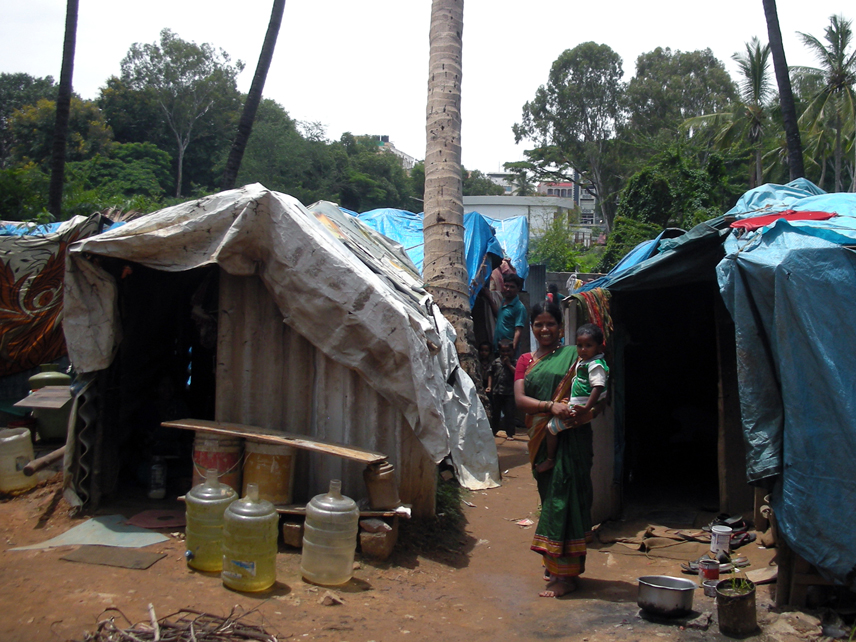
3. What is “slum”?
Slum may, of course, result from the deterioration of existing buildings and neighborhoods but in India slum is associated exclusively with informal urban settlements of tiny makeshift shacks made of scrap materials, including asbestos cement plates, metal sheets, tarpaulins, used bricks, waste wood, stones, leaves and mud, without proper (legal) infrastructures of water, electricity and sewage.
Most slum dwellings are erected by people who have no alternative options other than living in the street. Slums may thus be seen as the failure of the formal system to provide affordable housing for people with low incomes and limited financial assets. These people take matters into their own hands and create basic shelters for themselves. However, inasmuch as these “shelter-areas” are not formally integrated in the city, they often lack basic infrastructures and amenities; this lack gives rise to squalid living conditions.
Slums proliferate on leftover land around railway lines and electricity masts, close to landfills and contaminated land areas, polluted roads and mosquito-infested water bodies and since land is scarce in cities, these areas usually become very cramped.
While slums may, in fact, be hazardous for the people living there, they may also be categorized as such without any factual justification by municipalities that are eager to relocate slum dwellers so that the land can be freed up for commercial development, which constitutes an important source of revenue for many municipalities.
Furthermore, without land titles – and with land ownership being disputed, anyway, due to lack of proper survey and incomplete records (in many cases, municipalities own land that they are not even aware of owning) – slum dwellers are often left to the mercy of slum landlords, loan sharks and corrupt officials.
To the vast majority of rural migrants, however, the slum still presents the only possible gateway to the city, though it may take slum dwellers several generations to be included in and benefit from what the formal city has to offer. In the meantime, however, the slum dwellers may contribute significantly to other people’s enjoyment of those benefits.
But society could also draw inspiration from the resource-efficient culture of the slums, where hardly anything is wasted because almost everything is recycled, and often in a creative manner, as can be seen in the construction of many slum dwellings.
And slums are often vibrant socio-economic environments – full of entrepreneurial activities and a strong sense of community that many formal cities are lacking.
4. The Rajiv Awas Yojana
Slum is, nevertheless, a stark manifestation of how little we care for each other.21
However, “a country growing at above 8 per cent per year for over half a decade has the financial capability of providing minimum acceptable shelter to its slum population”.22
Thus, in 2009, the President of India, Pratibha Patil, announced that the government aimed to make India slum-free within five years.23
And in 2011, the Prime Minister, Manmohan Singh, formally launched the Rajiv Awas Yojana – a massive state-sponsored investment program, which “envisages a slum-free India, where every slum dweller and urban poor will have access to basic civic and social services and decent shelter”.24
Awas Yojana means “housing scheme” in Hindi. In 1985, under the administration of Rajiv Gandhi, the Indira Awas Yojana, named after his mother, Indira Gandhi, was initiated in order to provide housing for the rural poor.25
It has been argued that a major reason for the Rajiv Awas Yojana is to free up valuable land for commercial development in cities.26
In contrast to other initiatives,27 however, the Rajiv Awas Yojana does not allow more than 10 percent of slum dwellers to be relocated. Rather, it promotes the construction of affordable housing in the location of existing slums.
This concept of replacing slum with affordable formal housing in the very same neighborhood differs from both that of slum upgrading, which has been sponsored by the World Bank and other international institutions, and of the relocation of slum dwellers, practiced by China and also prevalent in many other places around the world.28
By rehabilitating slum dwellers where they already live instead of relocating them, many problems can be avoided, including the breaking-up of social networks, the deprival of livelihood opportunities, costly transportation and the degradation of traditional cultures and lifestyles.
The Rajiv Awas Yojana also demands that rehabilitated slum dwellers are given the rights to their new property. But how can property rights be granted to poor people in central locations of cities where land prices are often extremely high?
The Rajiv Awas Yojana has met with fierce opposition from various parties, not only from investors and developers who want to use centrally located areas for more lucrative developments and from some of the citizens who believe slum dwellers are parasites on the system29 but also, and perhaps more importantly, from politicians who depend on votes that they “buy” from slum-dweller communities by handing out “gifts” – such as private household consumer items, ration cards and money for school fees30 – in exchange for the slum-dwellers’ votes (the infamous “vote-bank politics”). Making slum-dwellers more independent of the system by ensuring proper living conditions, as envisioned in the Rajiv Awas Yojana, could put the career of many of those politicians in danger.
Even the NGOs that depend on the income from slum upgrading projects, may stand in opposition to the Rajiv Awas Yojana.
Thus, four years after the president had vowed to make Indian cities slum-free in five years, the Parliament’s Standing Committee on Urban Development, in a report from May 2013, blamed the Ministry of Housing and Poverty Alleviation for the “very slow progress of work” in carrying out the preparatory activities of the Rajiv Awas Yojana and strongly disapproved of the “inordinate delays” by cities in preparing slum-free plans.31
Then, in June 2013, the government announced that the norms of Rajiv Awas Yojana would be changed. Until then, one of the preconditions for receiving funding from Rajiv Awas Yojana had been the assignment of property rights. This would now be supplemented (or replaced) by other mechanisms like long-term leases.32
Shortly after, the new Minister of Housing and Urban Poverty Alleviation, Girija Vyas, was quoted33 as saying that the government was pursuing its vision of making India slum-free by providing housing facilities in 48 cities across 16 states of the country.34 When the Rajiv Awas Yojna was launched in 2011, the number was closer to 250 cities,35 which was still a far cry from the 2,543 statuary towns in which the 2011 Census had found slums.
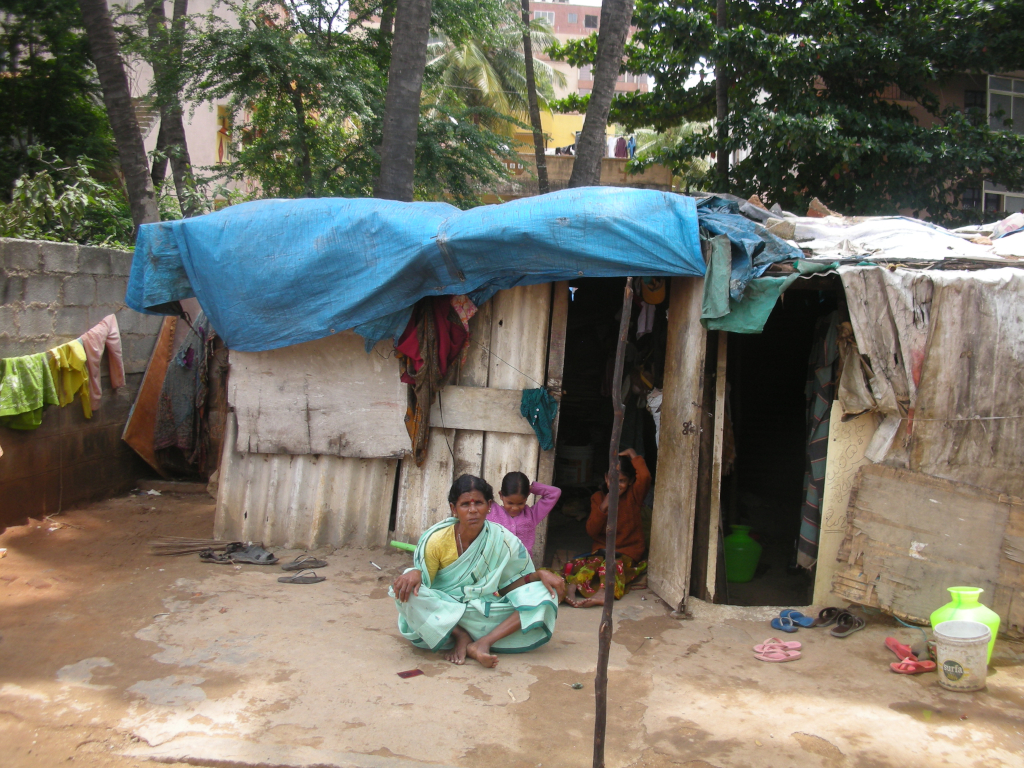
5. Bangalore – the never-ending promises
In March 2010, when the Indian People’s Party (BJP), the opposition party to the Indian National Congress (Congress), had won a majority of seats in the Greater Bangalore City Corporation (BBMP)36 election, the local leader, B.S. Yeddyurappa, said: “We will not allow new slums to come up in Bangalore and will improve civic amenities in the existing slums.”37
The promise to reduce and improve the slum in the city was part of a greater vision to make Bangalore a “world class city” within three years – through huge infrastructure expansion that would relieve the city of traffic chaos, power cuts, water shortage and garbage piling up in the streets.
BJP already had a majority of seats in the state parliament of Karnataka, the state in which Bangalore is the capital, so that, by all lights, it shouldn’t have been much of a problem to deliver on these promises.
Unfortunately, the party had other matters to attend to, such as the infamous case related to its mayor, Venkatesh Murthy, who had declared himself and his wife “landless labourers” in order to be awarded eight acres of land from the state government on the outskirts of Bangalore.
“I am not the only person who was allotted land under the Bagarhukum scheme. Plenty of other high profile politicians […] were allotted land under the same scheme. I do not want to take their names. I am being targeted unnecessarily even after the matter is closed,” Venkatesh Murthy was quoted as saying.38
Leading up to state elections in Karnataka in May 2013, the Congress Party, which won the elections, announced that they would make Bangalore slum-free in five years.39
Two weeks prior to that announcement, slum dwellers had gone to the Congress Party headquarters in Bangalore to “express their disgust” with the way party members had “blatantly colluded” with developers to displace over fifteen hundred families to make way for a new shopping mall. Then they went to the BJP headquarters and asked: “If we weren’t legitimate residents on this BBMP land reserved for housing poor people, why did the government issue us documents explicitly recognizing our rights of residence there?”40
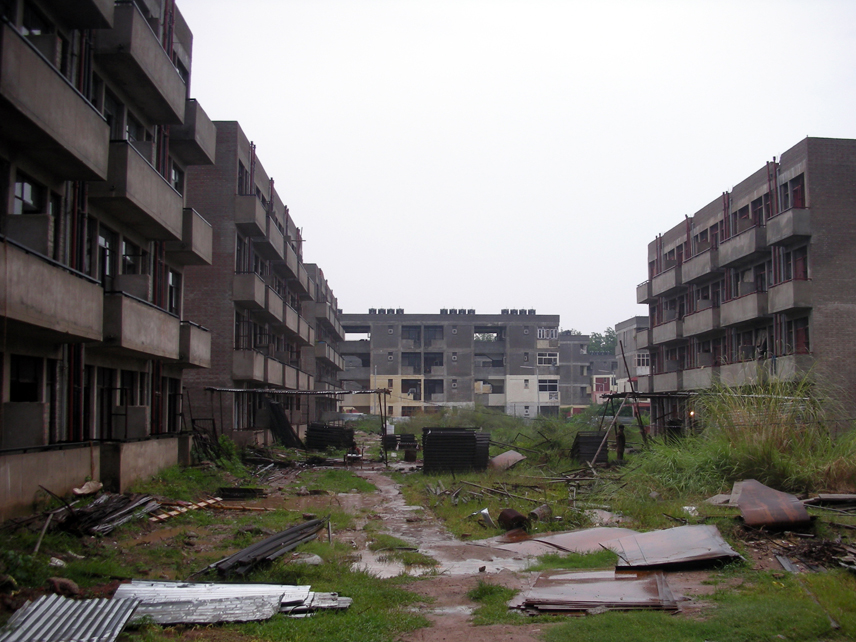
6. Chandigarh – the game of corrupt politics
In 2006, three years prior to the introduction of the Rajiv Awas Yojana, the decision was made to change Chandigarh into a “slum-free” city.41
Seven years later, Chandigarh’s Housing Board was still busy fulfilling this promise by shifting some 25,000 families, about 15 percent of the city’s total population, from 18 slum areas spread across the city to just four large rehabilitation colonies located on the outskirts of the city.42
Appropriately named the “Small Flats Scheme”, these colonies consist of varying numbers of identical 4-storey double blocks of 64 small flats each,43 placed one after the other in a rigid pattern intended for optimal land-use.
The whole thing is very schematic, very unimaginative and very uninspiring.
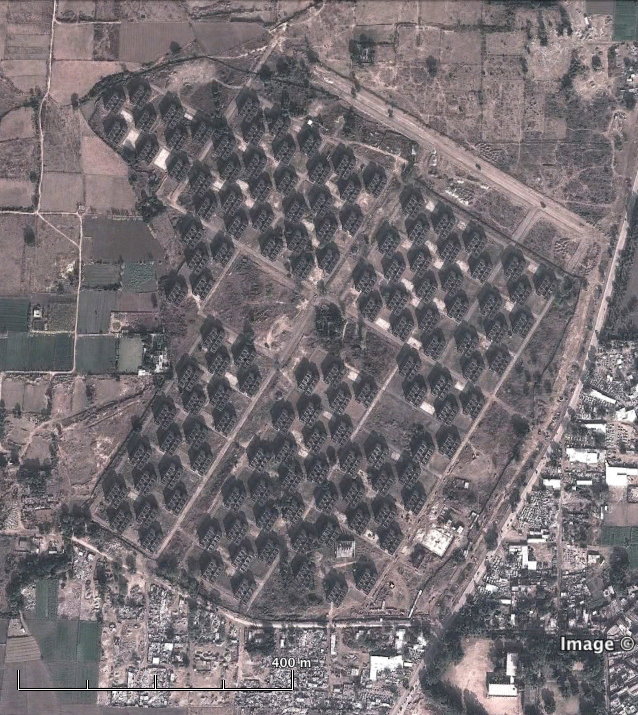
The largest colony, the Dhanas Rehabilitation Colony, is located on the western edge of the city. A small forest acts as buffer between the colony and the city, with the result that the colony remains altogether invisible from the city. Further to the west, a very different kind of urban life is being envisioned for the “New Chandigarh”. As one of the private real-estate developers describes the development that is now underway:
“Hyde Park Estate, DLF New Chandigarh’s first residential development, is spread over 200 acres oasis of lush green landscapes at the foothills of the Shivalik Mountain Range. Fringed with trees and dotted with manicured greens, it is a self-contained luxury township that celebrates life in all its radiant splendour”.44
Strategically located between “Old Chandigarh” and “New Chandigarh”, albeit at a proper distance from both, the Dhanas Rehabilitation Colony functions as a huge repository of cheap and readily available labor for the city and its citizens.
But why did the authorities decide to erect these colonies? And why did they act in such an unusually swift and efficient manner?
For corrupt politicians, there may be a strong political motivation in keeping people in poor living conditions within a confined area like a slum (a “vote-bank”) but there may also be a strong economic motivation to free up the land the slum dwellers occupy, especially if it happens to be centrally located, for commercial development (“land grabbing”).
So what is the solution to this dilemma?
In Chandigarh, slum dwellers are being re-located to so-called “rehabilitation colonies” on the outskirts of the city, where they may be even more dependent on the “gifts” from their elected representatives. The valuable land they occupied in the city can then be “sold” to developers and there may even be some “business opportunities” connected with handing out contracts to construct the rehabilitation colonies, using money from State-sponsored or State-subsidized programs.
This may also explain why the authorities go to the trouble of constructing houses for people who really just want a small piece of land on which they can build their own houses.
7. Conclusion
In India, the word “slum” refers to an informal urban settlement of tiny makeshift shacks where people live in unhygienic, unhealthy and unsafe conditions due to the lack of basic infrastructures and services.
Official statistics are uncertain, if not downright misleading, but there is no question that a very large number of urban dwellers in India live in slums.
An ambitious political initiative, the Rajiv Awas Yojana, has been launched and political promises are repeatedly being made, yet nothing much seems to be coming out of it. And even when something is being done, something like the Small Flats Scheme in Chandigarh, it doesn’t necessarily improve the lives of the slum dwellers. In fact, it may have the opposite effect, since the slum dwellers are consequently removed from livelihood opportunities and their social ties are being cut.
This also entails that the potential contribution to the development of the urban economy by an entrepreneurial and resource-aware segment of the population is being lost.
Thus, the failure to include slum dwellers in the formal city is a dual failure, not only to the slum dwellers, who are deprived of the chance to improve their lives, but also to the rest of the society, which is deprived of these people’s productivity.
The prospect of ending up in a slum – and the prospect of being stuck there – may discourage people from moving to cities, even if the situation in their village is desperate; this might explain why urban growth in India has been quite slow, as compared to other developing countries, most notably China. And this, in turn, may explain why China has been so much more successful than India in lifting people out of poverty.45
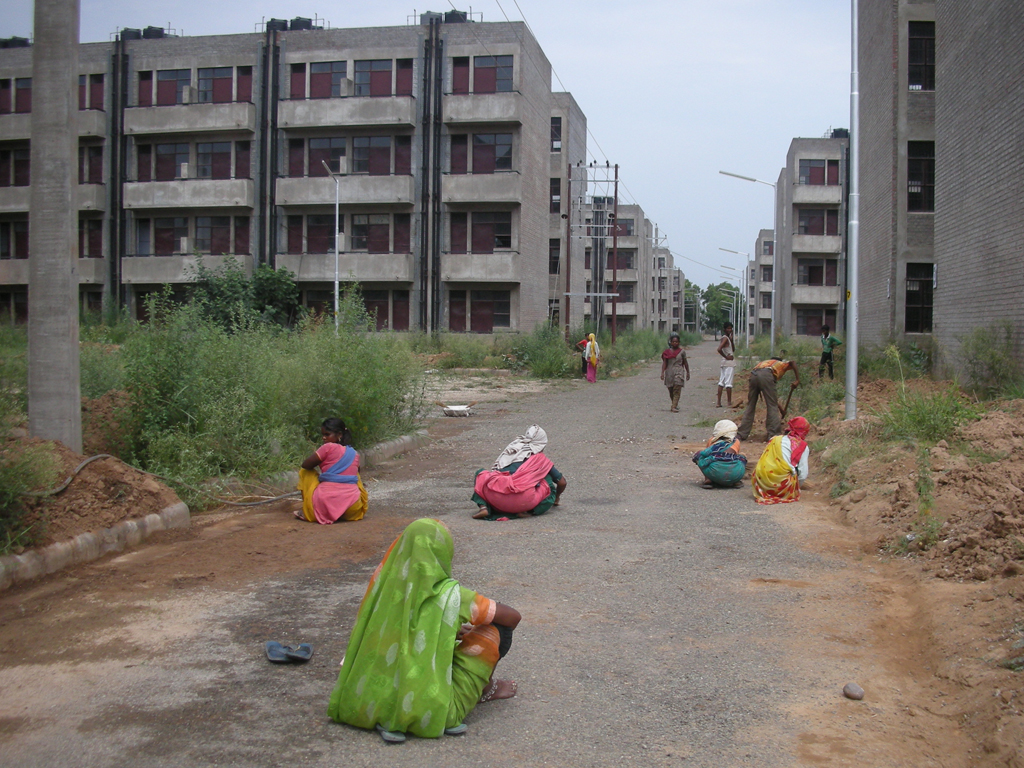
Notes
- People who live on less than 1.25 USD per day. In 2010, the average income of those people was 0.87 USD per day. Source: The State of the Poor: Where are the Poor and where are they Poorest?; The World Bank; 2013 ↩
- While the absolute number of people living in extreme poverty in India has remained constant – between 450 and 400 million for the past three decades – India’s share of the world’s extreme poor has increased: from 22 percent in 1981 to 33 percent in 2010. This is due to the fact that the relative number of people living in extreme poverty has decreased worldwide. Thus, in China, the number of people living in extreme poverty has been cut to less than one-fifth – from 835 million in 1981 to 156 million in 2010. Source: Ibid. ↩
- The urban population’s share of the total population in India increased from 28 percent in 2001 to 31 percent in 2011. In fact, the population increase in rural and urban areas was almost exactly the same (90 million in rural areas and 91 million in urban areas). Source: Office of the Registrar General & Census Commissioner of India: www.censusindia.gov.in (accessed August 22, 2013). In comparison, the urban population of China increased from 37 percent in 2001 to 51 percent in 2011. In fact, until 1987, India was more urbanized (25 percent) than China (24 percent). Source: The World Bank; Urban population (% of total): http://data.worldbank.org/indicator/SP.URB.TOTL.IN.ZS (accessed August 23, 2013) ↩
- Of the urban population increase, 24 percent stems from rural-to-urban migration, 32 percent from the formation of new towns and the expansion of existing urban areas and 44 percent from natural population growth. Source: Urban India 2011: Evidence; Indian Institute of Human Settlements; 2011 ↩
- The 2001 Census surveyed only towns with more than 50,000 inhabitants. In these 607 towns, 40,297,341 out of 178.393,941 inhabitants were found to be living in slums. Source: Statewise Slum Population in 2001; National Institute of Urban Affairs: http://www.niua.org/indiaurbaninfo/tablenew/table5.htm (accessed August 22, 2013) ↩
- The 2011 Census enumerated 13,749,000 out of 78,900,000 households living in slums, based on a survey of all 4,041 statuary towns of India. It did, however, leave out 3,894 so-called “census towns”. These are, quite literally, informal towns that mainly attract rural migrants. Between 2001 and 2011, the number of census towns grew by 186% (from 1,362 to 3,894) while the number of statuary towns grew by only 6% (from 3,799 to 4,041). This is important because rapidly growing towns are likely to generate much more slum than slowly growing cities. Source: Housing Stock, Amenities & Assets in Slums – Census 2011; Dr C. Chandramouli, Registrar General & Census Commissioner, India; 2011 ↩
- Source: Slum-free India scheme to be taken up as national mission; The Hindu Business Line; August 15, 2011: http://www.thehindubusinessline.com/industry-and-economy/slumfree-india-scheme-to-be-taken-up-as-national-mission/article2358846.ece ↩
- The 2011 Census found 13,749,000 households living in slum. Using an estimate of 4.78 members per household, this figures out to about 66 million people. ↩
- Quoted from: Housing Stock, Amenities & Assets in Slums – Census 2011; Dr C. Chandramouli, Registrar General & Census Commissioner, India; 2011 ↩
- Without legal entitlements to land, slum dwellers are constantly facing the risk of being evicted. ↩
- See, for instance: The Other Path: The Invisible Revolution in the Third World; Hernando de Soto Polar; 1986 ↩
- All numbers relate to urban households only and are sourced from: Housing Stock, Amenities & Assets in Slums – Census 2011; Dr C. Chandramouli, Registrar General & Census Commissioner, India; 2011 ↩
- 2,543 out of 4,041 statuary towns. ↩
- The average per capita GDP is three times higher in Andhra Pradesh than in Bihar. Source: List of Indian states by GDP; Wikipedia: http://en.wikipedia.org/wiki/States_of_India_by_size_of_economy (accessed August 22, 2013) ↩
- Calculations are based on the average household having 4.78 members. ↩
- 35.1% in Bihar and 33.4% in Andhra Pradesh. Source: Office of the Registrar General & Census Commissioner of India: www.censusindia.gov.in (accessed August 22, 2013) ↩
- See for instance: Data on Indian Slums; Uthara Ganesh; April 19, 2013: http://urbanpoverty.intellecap.com/?p=879 ↩
- Source: 17% of urban India lives in slums: Census (comments); The Times of India; March 22, 2013: http://timesofindia.indiatimes.com/opinions/19118219.cms ↩
- Quoted from: 17% of urban India lives in slums: Census; The Times of India; March 22, 2013: http://timesofindia.indiatimes.com/india/17-of-urban-India-lives-in-slums-Census/articleshow/19118219.cms ↩
- Source: By 2017, India’s slum population will rise to 104 million; The Times of India; August 20, 2013: http://timesofindia.indiatimes.com/india/By-2017-Indias-slum-population-will-rise-to-104-million/articleshow/21927474.cms ↩
- The world’s supposedly most expensive home, constructed by Makesh Ambani for his family, their guests and servants at an estimated cost of more than one billion USD, is located in Mumbai, where roughly half the population lives in slums. ↩
- Quoted from: Political Economy of Making Indian Cities Slum-Free; Amitabh Kundu; 2013 ↩
- Source: UPA’s target: A slum-free India in 5 years; The Times of India; June 05, 2009: http://articles.timesofindia.indiatimes.com/2009-06-05/india/28183870_1_rajiv-awas-yojana-slum-free-housing-scheme ↩
- Quoted from: Slum-free India scheme to be taken up as national mission; The Hindu Business Line; August 15, 2011: http://www.thehindubusinessline.com/industry-and-economy/slumfree-india-scheme-to-be-taken-up-as-national-mission/article2358846.ece ↩
- It would seem that Indira Gandhi has been bestowed with the role as the goddess of rural India and Rajiv Gandhi as the god of urban India. ↩
- Slum development in India does not concentrate in the suburbs but rather in “leftover” areas in the cities. As cities develop, these areas become attractive for commercial development. ↩
- Such as, for instance, the Small Flats Scheme in Chandigarh, which is organized around an intention to relocate the entire slum population of the city to a few large “rehabilitation colonies” on the outskirts of the city. ↩
- For instance: 1) The eviction of millions of people in Seoul between 1970 and the early 1990s. Source: New shantytowns and the urban marginalized in Seoul Metropolitan Region; Seong-Kyu Ha; 2002. 2) The continuous slum clearances of maybe a million people in Lagos over the last fifteen years. Source: In Nigeria’s Largest City, Homeless Are Paying the Price of Progress; The New York Times; March 1, 2013: http://www.nytimes.com/2013/03/02/world/africa/homeless-pay-the-price-of-progress-in-lagos-nigeria.html. 3) The demolition of favelas in Rio de Janeiro and other Brazilian cities leading up to the 2014 World Cup and the 2016 Olympics. Source: Rio de Janeiro’s Favelas: The Cost of the 2016 Olympic Games; ArchDaily; March 12, 2012: http://www.archdaily.com/214726/rio-de-janeiros-favelas-the-cost-of-the-2016-olympic-games/ ↩
- Widespread popular belief about slum dwellers is expressed in the following comment to a news story about the 2011 Census on slum: “And these urban slum dwellers love it. They don’t pay any taxes; get water from illegal connections and squatter in the open. They just like to misuse the system to the maximum. That’s the true definition of slum dwellers in urban India.” Pallavi BV (Port Louis). Quoted from: 17% of urban India lives in slums: Census (comments); The Times of India; March 22, 2013: http://timesofindia.indiatimes.com/opinions/19118219.cms ↩
- Source: The Micro-Politics of Vote Banks in Karnataka; Mary E. Breeding; 2011 ↩
- Source: Slum removal scheme tweaked to make it more effective; Zee News; June 18, 2013: http://zeenews.india.com/news/nation/slum-removal-scheme-tweaked-to-make-it-more-effective_855854.html ↩
- Source: Ibid. ↩
- Source: Government committed to make India slum-free: Girija Vyas; The Economic Times; June 24, 2013: http://articles.economictimes.indiatimes.com/2013-06-24/news/40166685_1_slum-dwellers-rajiv-awas-yojna-housing-and-basic-amenities ↩
- The costs to be borne by the state for 55 projects of housing and basic amenities for slum dwellers in 48 cities were estimated to be 25 billion rupees. Source: Ibid. ↩
- Source: Rajiv Awas Yojana for slum dwellers approved; The Hindu; June 2, 2011: http://www.thehindu.com/news/national/rajiv-awas-yojana-for-slum-dwellers-approved/article2070897.ece ↩
- The Greater Bangalore City Corporation is the third instance of government after the State Government of Karnataka and the National Government of India. ↩
- Source: BJP wins Bangalore civic polls, promises slum-free city; TwoCircles.net; April 5, 2010: http://twocircles.net/node/195730 ↩
- Quoted from: Bangalore mayor becomes landless labourer for 15 acres of govt land; India Today; August 21, 2012: http://indiatoday.intoday.in/story/bangalore-mayor-becomes-landless-labourer-for-15-acres-of-govt-land/1/214082.html. For more allegations related to the same scam, see: Lok Satta expose big housing scam in Karnataka: BJP Dy CM & Home Minister Kingpin; Exit and Opinion Polls India; November 8, 2012: http://exitopinionpollsindia.blogspot.in/2012/11/lok-satta-expose-big-housing-scam-in.html ↩
- Source: Congress promises slum-free Bangalore; The Times of India; April 26, 2013: http://articles.timesofindia.indiatimes.com/2013-04-26/bangalore/38842640_1_bbmp-service-providers-fast-track-courts ↩
- Quoted from: Bangalore slum dwellers protest against politicians; OneIndia; April 11, 2013: http://news.oneindia.in/2013/04/11/bangalore-slum-dwellers-protest-against-politicians-1191469.html ↩
- Source: CHB Projects/Activities; Chandigarh Housing Board: http://chandigarh.gov.in/chb_projects.htm (accessed August 23, 2013) ↩
- The largest of the four colonies is the Dhanas Rehabilitation Colony, with 8,448 dwelling units. It was ready for occupation in spring 2013 but was lying vacant until autumn of the same year. On the 14th of September 2013, the colony was finally inaugurated by Manmohan Singh, the Prime Minister of India. Sources: Flats for poor empty as UT awaits VVIP inauguration; The Indian Express; June 21, 2013: http://m.indianexpress.com/news/flats-for-poor-empty-as-ut-awaits-vvip-inauguration/1131797/ and Hope Chandigarh becomes India’s first slum-free city: Manmohan Singh; IBN Live; September 14, 2013: http://ibnlive.in.com/news/hope-chandigarh-becomes-indias-first-slumfree-city-manmohan-singh/421933-3.html ↩
- Each flat consists of one open room and one enclosed bathroom, measuring 3.1 x 7.3 meters in total. In addition, each flat has a tiny balcony. ↩
- Source: Introduction to DLF New Chandigarh; DLF: http://www.dlf.in/dlf/wcm/connect/residential/Homes/Residential/Projects/Luxury+Homes/Hyde+Park,+New+Chandigarh/ (accessed January 28, 2014) ↩
- Thirty years ago, there were roughly twice as many people living in extreme poverty in China as in India; today, there are less than half. Source: The State of the Poor: Where are the Poor and where are they Poorest?; The World Bank; 2013 ↩